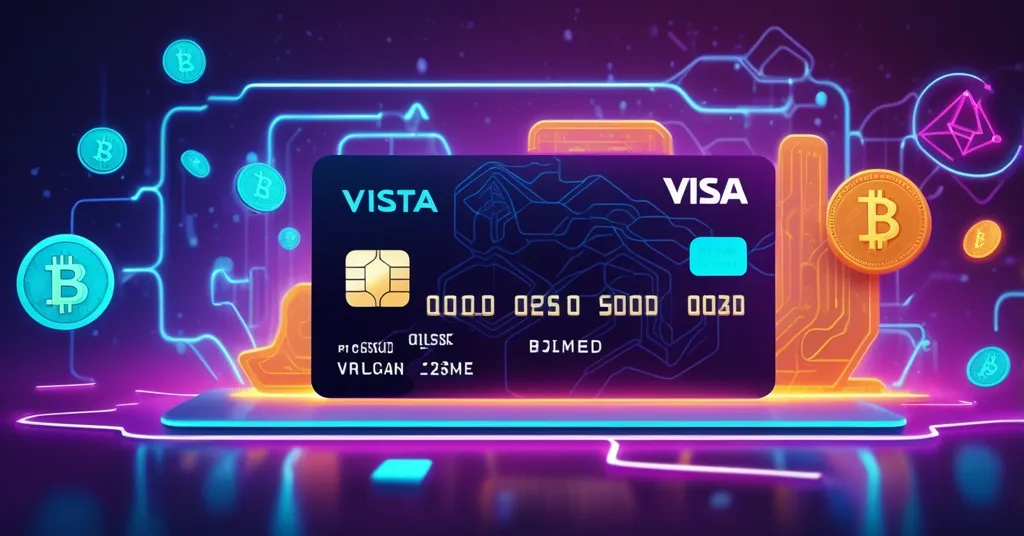Visa Rumors: Digitap ($TAP) Over Ripple (XRP) – Innovation or Hype?

Visa’s Rumored Shift to Digitap ($TAP) Over Ripple (XRP): Innovation or Overblown Hype?
Word on the crypto street is that Visa, the heavyweight of global payments, might be sidestepping Ripple (XRP) in favor of a fresh-faced contender, Digitap ($TAP), for its next blockchain payment venture. This rumor, if substantiated, could mark a pivotal moment in blending traditional finance with decentralized tech—or it might just be another presale puff piece designed to fleece eager investors.
- Visa’s Potential Pivot: Unconfirmed reports suggest Visa is favoring Digitap over Ripple for blockchain payment integrations.
- Ripple’s Woes: XRP struggles with stagnant prices and a lack of retail appeal due to its institutional focus.
- Digitap’s Promise: A user-friendly platform with Visa-connected crypto cards, privacy options, and a speculative 40X rally prediction for $TAP.
Ripple’s Dimming Spotlight: Why XRP Can’t Break Free
Ripple has been a household name in blockchain since its early days, revolutionizing cross-border payments with its native token, XRP. Designed to enable near-instant transactions for banks and financial institutions, XRP promised to slash the costs and delays of traditional systems like SWIFT. Yet, despite its pioneering status, XRP has been mired in mediocrity. Its price lingers below $3, weighed down by relentless selling pressure from large investors—often referred to as “whales” in crypto lingo—who dump tokens on the market, keeping gains suppressed.
More critically, Ripple’s laser focus on institutional clients has left retail users out in the cold. Unlike platforms that cater to everyday folks looking to buy, spend, or trade crypto, XRP’s utility is largely locked behind corporate walls. Your average user isn’t wiring millions across borders; they want tools to pay for groceries or send small sums peer-to-peer. Ripple hasn’t delivered on that front. Then there’s the elephant in the room: Ripple’s ongoing legal tussle with the U.S. Securities and Exchange Commission (SEC). The SEC claims XRP is an unregistered security, not a currency, which could slap it with heavy regulations if the court rules against Ripple. This uncertainty has spooked investors and stifled momentum, painting XRP as a risky bet despite its established network of banking partnerships.
Digitap Enters the Ring: A Fresh Take on Crypto Payments
Against this backdrop steps Digitap, a fintech-blockchain hybrid pitching itself as the answer to Ripple’s shortcomings. Unlike XRP’s institutional bent, Digitap targets regular users with what it calls an “omni-banking platform.” This setup aims to merge traditional fiat money (like dollars or euros) with cryptocurrencies in a single account, making it seamless to switch between the two. Imagine checking your bank balance and crypto holdings in one app, then swiping a Visa-connected payment card to buy a latte with either—or both. Digitap claims to support not just Visa cards but also Apple Pay and Google Pay, aiming to weave crypto into daily spending as effortlessly as tapping your phone.
For privacy advocates, Digitap dangles an intriguing carrot: optional no-KYC (Know Your Customer) onboarding. KYC is a standard process where financial platforms verify your identity—think uploading your ID or passport. Many in the crypto space loathe it, seeing it as a betrayal of decentralization’s promise of anonymity. Digitap offers a choice: go no-KYC for privacy or opt for full compliance if you prefer sticking to regulatory norms. This flexibility could attract a wide swath of users, from cypherpunks championing freedom to cautious mainstream adopters.
Powering this ecosystem is Digitap’s native token, $TAP. It’s used for payments, rewards, and governance—meaning holders can vote on platform decisions. With a fixed supply of 2 billion tokens, Digitap employs a deflationary model, where a chunk of platform profits (reportedly 50%) funds buybacks and burns. In simple terms, “burning” removes tokens from circulation forever, reducing supply to potentially boost value over time, much like limiting how much money a government prints. $TAP also supports staking, where users lock up tokens to help secure the network and earn rewards—akin to earning interest on a savings account. Unlike many projects that inflate their token supply with endless rewards, Digitap claims its staking pool is preset, avoiding dilution and encouraging long-term holding.
Currently in presale, $TAP tokens are priced low, with plans for incremental increases in upcoming rounds. This early stage has sparked buzz, with some bold voices predicting a massive rally once $TAP hits public exchanges. They point to its practical utility in payments, the rumored Visa tie-in, and the broader trend of fintech-blockchain integration as fuel for explosive growth, as highlighted in discussions around Visa’s potential shift to Digitap over Ripple. But let’s not get swept away by fairy tales—more on that skepticism shortly.
Visa’s Role: Rumor or Reality?
Here’s where the ground gets shaky. The notion that Visa is cozying up to Digitap over Ripple comes from unverified reports, often wrapped in sponsored content. There’s no official press release, no executive quote, nothing concrete to hang your hat on. Visa has dipped its toes into blockchain before—think partnerships with Crypto.com for payment cards or pilot projects exploring decentralized tech—but specifics on Digitap are absent. If true, Visa’s backing could be a game-changer, lending massive credibility to $TAP and accelerating crypto’s march into mainstream finance. Imagine swiping a crypto card at any Visa terminal worldwide; that’s the kind of adoption we dream of in this space.
Yet, without hard proof, this smells like presale hype—a common tactic to lure investors with big-name associations that may never materialize. Visa’s strategy in blockchain payments has been cautious, often aligning with proven players rather than untested startups. Ripple, despite its struggles, has a track record with institutions that Digitap can’t match. Why would Visa pivot to a newcomer? Until we see a signed dotted line, treat this as speculation, not gospel.
The 40X Rally Hype: Fairy Tale or Feasible?
Speaking of speculation, let’s address the elephant in the room: the prediction of a 40X rally for $TAP. Some analysts—or perhaps just enthusiastic shillers—claim that once listed on exchanges, $TAP could skyrocket due to its early-stage status, practical use cases, and potential Visa connection. I’m calling absolute nonsense on this. These kinds of price predictions are often pulled out of thin air, lacking any grounding in data or fundamentals. They’re designed to whip up FOMO (Fear of Missing Out) during presales, not to inform. Sure, early crypto projects can see wild gains—look at some altcoins in 2017 or 2021—but for every winner, there are a hundred duds that crash to zero. Without proof of demand, adoption, or even Visa’s involvement, banking on a 40X surge is like betting your life savings on a coin flip. Don’t fall for it.
Risks and Red Flags: Presale Pitfalls and Privacy Perils
Presales are a notorious wild west in crypto. Investors pour money into unproven projects based on whitepapers and promises, often only to see developers vanish with the funds in a “rug pull” or fail to deliver a working product. Digitap’s buzz is tied to sponsored content, with disclaimers from hosting platforms like CaptainAltcoin explicitly warning against blind investment. They’re not wrong—crypto is high-risk, and presales are the riskiest of all. Digitap might have a slick pitch, but execution is everything, and we’ve seen too many flashy startups flop.
Then there’s the privacy angle. No-KYC options sound great for those of us who value anonymity as a core tenet of decentralization, but they’re a magnet for regulatory heat. Governments and watchdogs often view such features as loopholes for money laundering or illicit activity. Look at Binance’s early no-KYC offerings; they faced intense scrutiny and had to tighten up. Digitap’s balancing act between freedom and compliance could easily tip into trouble if regulators crack down. It’s a gamble for users and the platform alike.
The Bigger Picture: Where Do Bitcoin and Others Fit?
As a Bitcoin maximalist at heart, I’ll admit neither XRP nor $TAP comes close to BTC as the ultimate decentralized store of value. Bitcoin’s strength lies in its unassailable security and ethos of freedom, not in being a day-to-day payment tool. That said, its transaction speed and fees make it less ideal for buying coffee—though solutions like the Lightning Network are closing that gap with near-instant, low-cost transfers. Altcoins and newer platforms often fill niches Bitcoin doesn’t, and that’s fine. Ripple’s institutional focus serves a purpose, even if it’s niche. Digitap, if it delivers, could tackle retail payments and privacy in ways BTC doesn’t prioritize.
But let’s not ignore other players. Ethereum-based solutions, with smart contracts enabling programmable money, are also vying for a slice of the payments pie. Projects like Polygon or Solana offer fast, cheap transactions that could rival Digitap’s vision. This isn’t a two-horse race; it’s a crowded field, and betting on any single contender—especially an unproven one—requires serious caution.
Playing Devil’s Advocate: Is Ripple Still Relevant?
Before we write off Ripple entirely, consider this: its institutional focus might be a long-term strength. If banks and financial giants fully embrace blockchain for cross-border transfers—a market still plagued by inefficiency—XRP’s established partnerships could make it indispensable. Retail adoption isn’t everything; sometimes, the back-end infrastructure matters more. Digitap’s retail-first approach is appealing, but untested platforms face a steeper climb to credibility than a veteran like Ripple, legal woes or not. Maybe XRP’s slow burn is just patience before a bigger payoff.
Key Takeaways and Questions Answered
- Why is Ripple (XRP) losing ground in the crypto payments space?
XRP’s focus on institutional users over retail ones limits its appeal, while whale selling pressure and an SEC lawsuit over its status as a potential security dampen investor confidence. - What makes Digitap ($TAP) different from Ripple?
Digitap targets everyday users with a unified fiat-crypto platform, Visa-connected payment cards, and privacy options like no-KYC onboarding, contrasting Ripple’s bank-centric model. - Is Visa’s partnership with Digitap confirmed, and what could it mean?
No official evidence supports Visa’s involvement with Digitap; it’s based on unverified, sponsored content. If true, it could massively boost crypto’s mainstream adoption through trusted payment infrastructure. - How realistic is the 40X rally prediction for $TAP?
It’s highly speculative and lacks supporting data, typical of presale hype meant to drive FOMO. Such predictions should be met with deep skepticism given crypto’s volatility. - What risks should investors weigh with Digitap’s presale?
Presales carry extreme risks, including project failure or scams like rug pulls. Sponsored content promoting Digitap also suggests bias, and privacy features could invite regulatory scrutiny.
Digitap’s vision of blending fiat and crypto with privacy and usability resonates with the push for decentralization and disrupting outdated financial systems—core values we hold dear. As an advocate for effective accelerationism, I’m all for tech that solves real problems at warp speed. But hype without substance is a plague in this space, and Digitap’s story reeks of it until proven otherwise. Ripple may be faltering, but it’s a known entity in a sea of maybes. For now, $TAP is a high-stakes roll of the dice—potentially a jackpot if they deliver, but more likely a bust if they don’t. Keep your wits sharp and your investments cautious; in the race to reinvent finance, staying grounded is the only way to win.



